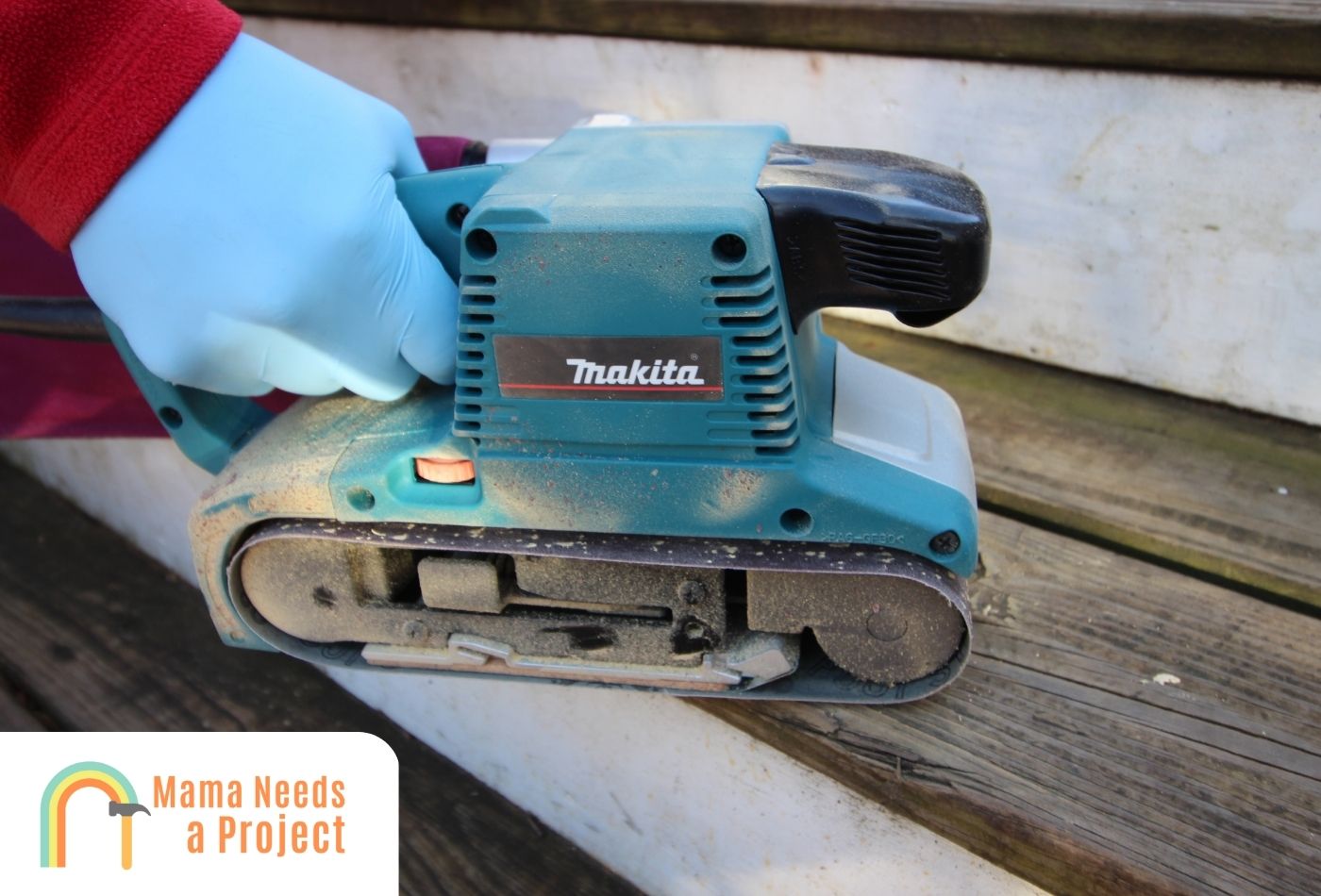I Tested 7 Sanders for Decks: Here are the Best (2024)
Looking to refinish your old deck? One tool you don’t want to get started without is a power sander.
Could you imagine how long it would take to sand a deck by hand? No thanks!
That’s why I put together this list of the best sanders for deck refinishing so you can get the job done quickly and efficiently.
If you’re in a hurry, my top choice is the Makita 9403 Belt Sander because it offers a powerful motor and large sanding surface that’ll make your job a breeze.
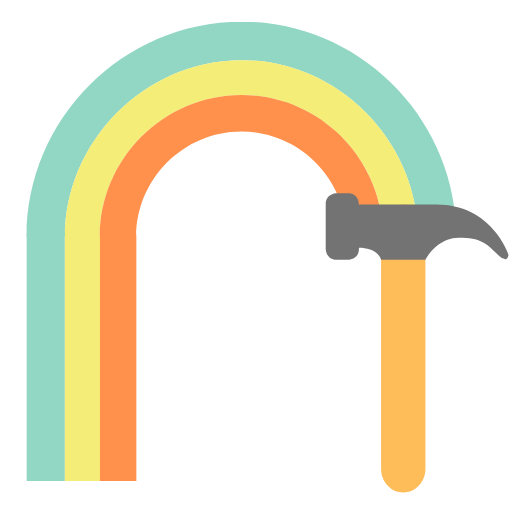
We’re committed to providing unbiased reviews of products that are thoroughly tested based on a multitude of factors. We do not consider affiliate relationships when determining how to choose or rank products. Read more about our reviews process here. Have questions? Email reviews@mamaneedsaproject.com for more info.
- 7+ sanders thoroughly vetted and hand tested
- 22+ data points and key considerations
- 19+ hours of use and analysis
My Favorite Sanders for Deck Refinishing
- Makita Belt Sander – #1 Best Overall
- DeWalt Orbita Sander – Best Orbital Sander for Decks
- SKIL Belt Sander – Best Value Belt Sander
- Metabo HPT Belt Sander – Best for Large Decks
- Craftsman Belt Sander – Best Budget Sander for Medium Sized Decks
- BLACK+DECKER Orbital Sander – Best Value Orbital Sander
- Makita Finishing Sander – Best for Small Decks
Compare the Top Deck Sanders
| Product | Max Speed | Size | Motor | Warranty | Read Review |
|---|---|---|---|---|---|
| Makita Belt Sander | 1,640 FPM | 4″ x 24″ | 11 amps | 1-year | See Review ↓ |
| DeWalt Random Orbital Sander | 12,000 OPM | 5″ | 3 amps | 3-years | See Review ↓ |
| Skil Belt Sander | 900 FPM | 3″ x 18″ | 6 amps | 2-years | See Review ↓ |
| Metabo HPT Belt Sander | 1,475 FPM | 3″ x 21″ | 9 amps | 5-years | See Review ↓ |
| Craftsman Belt Sander | 800 FPM | 3″ x 21″ | 7 amps | 3-years | See Review ↓ |
| BLACK+DECKER Orbital Sander | 12,000 OPM | 5″ | 2 amps | 2-years | See Review ↓ |
| Makita 1/2 Sheet Finishing Sander | 10,000 OPM | 4.5″ x 9″ | 2 amps | 1-year | See Review ↓ |
1. Makita 9403 Belt Sander – #1 Best Overall & Best Belt Sander for Deck
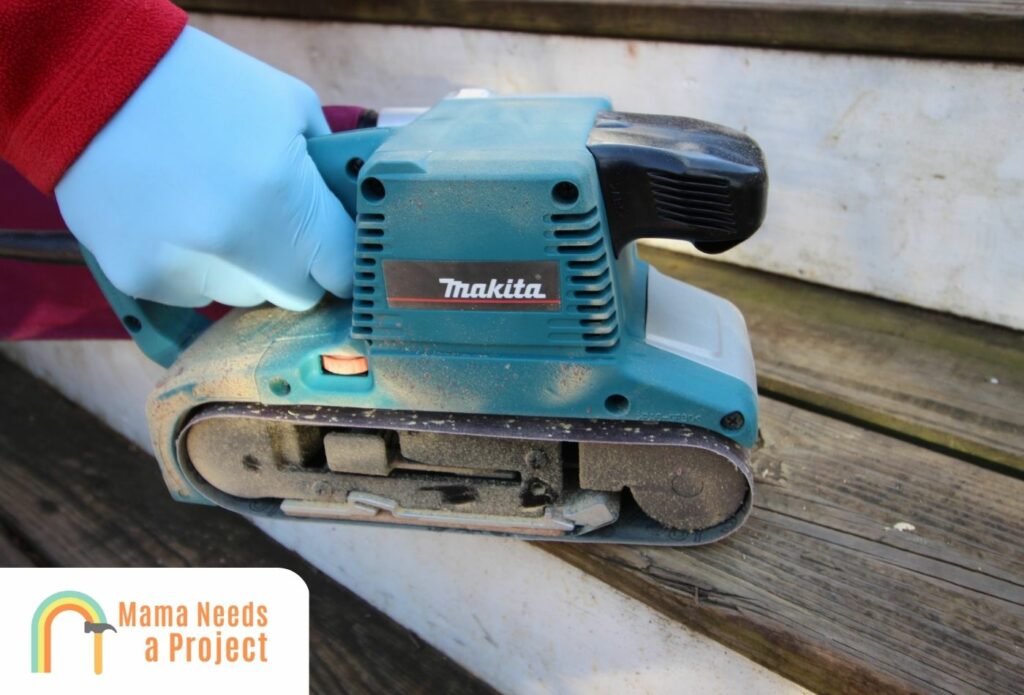
- Low noise (84dB) for operator comfort
- 4″ wide belt with a speed of 1,640 ft./min. for fast material removal
- Labyrinth construction seals and protects motor and bearings from dust and debris for longer tool life
The Makita 9403 Belt Sander has a powerful, 11-amp motor that drives a 4” x 24” belt making it an amazing decking sander for larger jobs and the best belt sander you can buy. This puts it on the large side for a belt sander, which is a good thing and a bad thing. On the plus side, an experienced sander can cover a large area in a hurry. On the downside, it’s heavier than many other sanders.
In terms of efficiency, the 9403 is tough to beat. It can chew through even the toughest finishes with no issues. And despite all that power, it’s a surprisingly quiet little machine. So if you need to paint a deck with peeling paint – this bad boy will easily remove the chipped paint from your old wooden deck. This is also one of the best sanders for removing paint.
As a bonus, this belt sander can be used for many other tasks outside of your deck refinishing project. Consider it a two for one.
The one thing that I didn’t really like is that it is a corded sander. So depending on the size of your surface, you’ll have to have an extension cord to sand your entire deck.
I should point out that Makita brand tools are professional-grade, and they come with a rather high price tag. If you’re willing to pay more to get the best tool, the choice is a no brainer. But if this is a one-off project and you’re on a tight budget, you’ll want to choose a different brand.
What I Liked:
- Has an extremely powerful motor
- Large drive belt that makes sanding faster
- Tough and durable so it should last for years
What I Didn’t Like:
- More expensive than others
- A bit heavy – shoulder was getting tired after a long day of sanding
- Corded (so you’ll need an extension cord)
My Thoughts
The Makita 9403 Belt Sander is the most powerful choice on my list and it’s also my favorite belt sander out there. It’s not cheap, but it’s big, beefy, and can power through the toughest deck refinishing projects without a hitch. It’s as tough and reliable as they come – and despite this, it runs quiet enough not to disturb the neighbors. This is a corded sander – which is something to keep in mind but overall this is a perfect belt sander for decking.
More Stores
2. DeWalt Random Orbital Sander – Best Orbital Deck Sander
- 3.0-amp motor of the orbital sander spins the pad at 8,000 – 12,000 OPM
- Shorter height of the hand sander allows the user to get closer to work piece
- Separate counterweight design reduces vibration for improved comfort of the electric sander
If you prefer to work with a random orbit sander, it’s tough to go wrong with the DeWalt DWE6423K Random Orbital Sander. It’s on the larger side for an orbital, with a 5-inch pad that can cover a reasonable amount of area when sanding your deck.
The rubber grip is soft and ergonomic, and the control switch and speed dial are easy to operate.
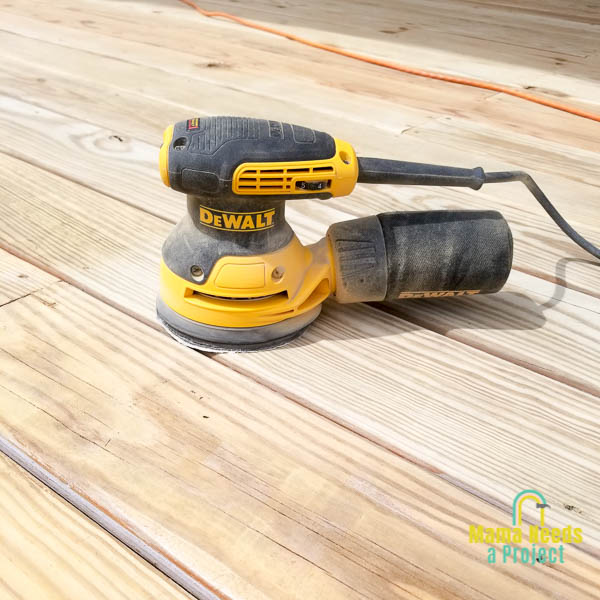
This is a great orbital sander, and can produce an exceptionally smooth finish when you need it to. This is of little value on a deck, but it does give the sander some added value. For example, you can sand your wood patio furniture when you’re done with your deck. I really liked the dust capture system, which has a surprisingly large bag for an orbital.
Just like the Mikita, DeWalt is a good brand, so you’re going to pay for the name. Once again, it’s going to last so I think it’s worth the price. But if you’re on a budget, you might consider another option.
What I Liked:
- Large 5-inch sanding surface which is larger than other random orbital sanders
- Great for precision jobs
- Generous dust bag
- Quieter than belt sanders
What I Didn’t Like:
- Slower than a belt sander
- A bit pricey, but worth it
- Corded, something to keep in mind
My Thoughts
The DeWalt DWE6423K Random Orbit Sander is a well-engineered little machine. It’s nowhere near as fast as a belt sander, but it’s one of the faster random orbital sanders around and great for decks. Ultimately, if you want to avoid belt sanding – go with this DeWalt sander.
More Stores
3. Skil 7510-01 Belt Sander – Best Value Belt Sander
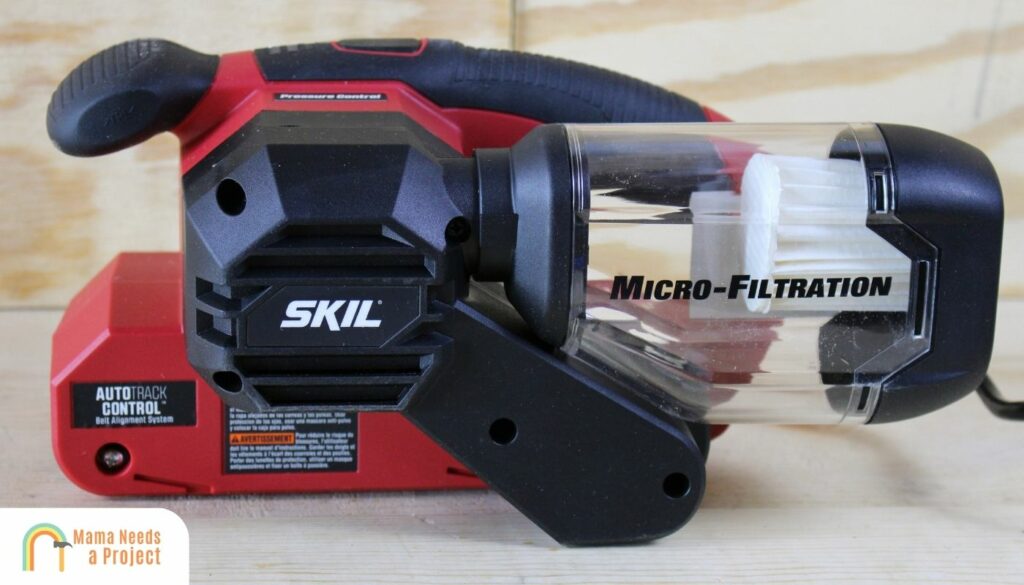
- Pressure control technology warns user when excessive pressure is applied
- 6.0 A of power sands any type of wood surface
- Micro-filtration captures and contains fine dust particles
The Skil 7510-01 Belt Sander is a bit more compact than the Makita belt sander which can be convenient for tight spaces. It has a smaller, 3” x 18” belt, with a correspondingly smaller 7-amp motor.
The motor provides more than enough power for the smaller belt, although you still won’t be able to sand as quickly. Since you’re sanding less surface area at a time, it’s going to take some extra time to complete your deck refinishing project.
There are two features that make this sander stand out.
The first is the large, easy-to-operate belt release lever. It can be opened and closed very quickly, which makes changing sanding belts a breeze.
The other is the dust collection system. It’s large, with a clear plastic hopper that lets you see clearly that it’s full. Unfortunately, it also pops off easily when you’re sanding, so you have to be careful. TIP: I actually used some tape to keep it in place when sanding.
This is also one of the quietest belt sanders I tested and it’s priced at a great value. I was actually surprised to see how low the price was given the quality of other Skil products.
Finally, the dual grip design is super comfortable.
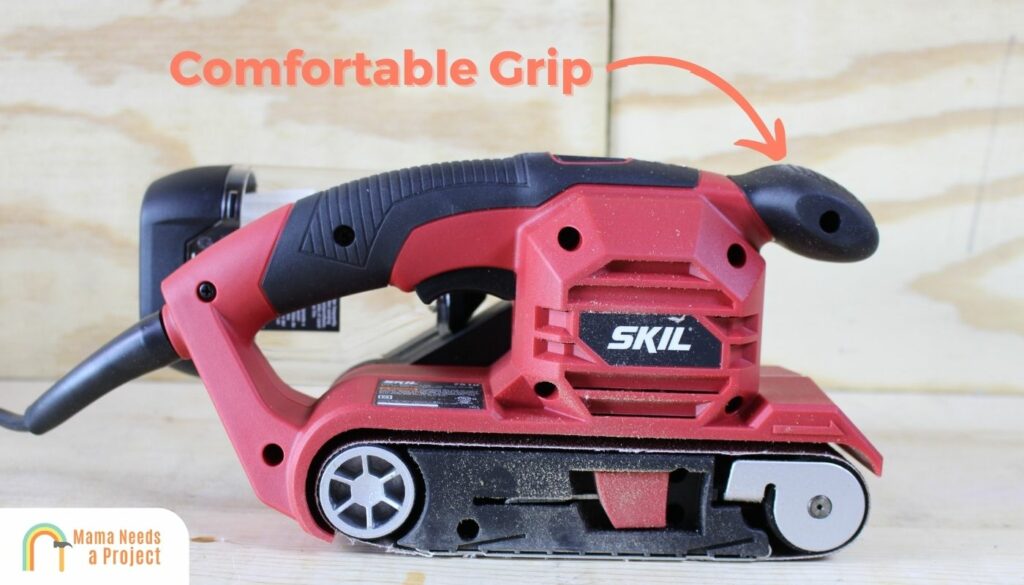
What I Liked:
- Easy belt replacement that takes less than a minute
- Great value considering the brand and price
- Large and clear dust collector that makes it easy to see when it’s full
- Comfortable dual grip
What I Didn’t Like:
- Dust collector tends to pop off
- Small belt which makes sanding take longer
My Thoughts
This Skil belt sander is one of the best sanders for deck refinishing because of it’s value, versatility, and quality. While it’s going to be slower than the Makita and DeWalt above, it’s a quality sander for wooden decks that’ll make your job easy. The big bonus of this belt sander is the price. It’s hard to beat given the cost making it an awesome choice that I highly recommend if you’re on a budget.
More Stores
4. Metabo HPT Belt Sander – Best for Large Decks
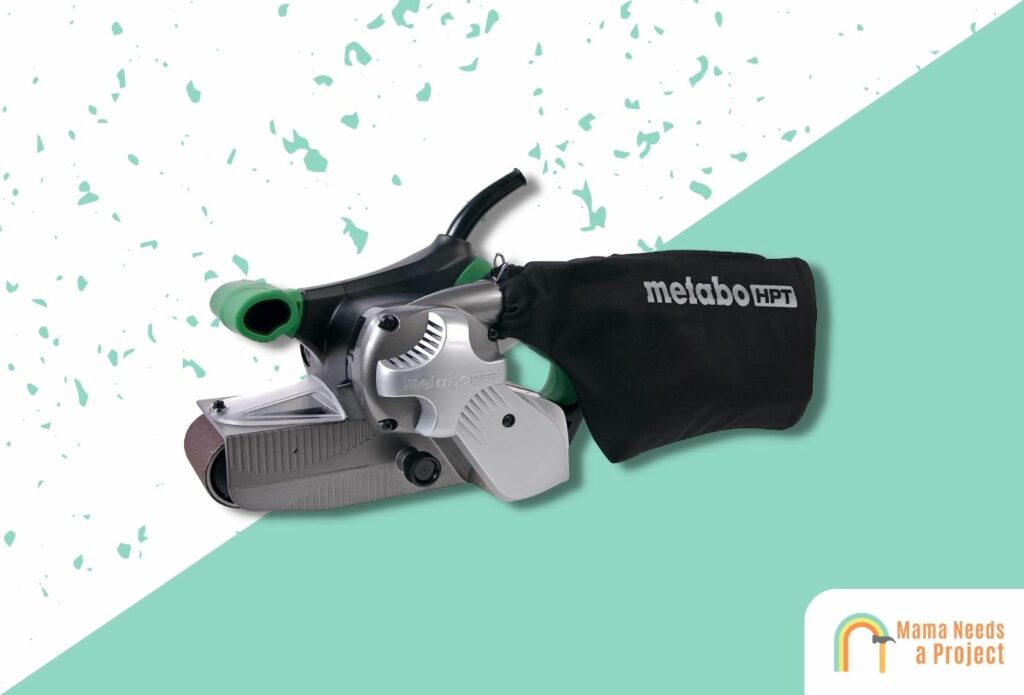
- INCLUDES: SB8V2 Belt Sander, Sanding Belt, Dust Bag
- MOTOR: 9 amp 1,020-watt motor, forcible power for the toughest sanding jobs
- SPEED CONTROL: Variable speed dial at base of handle for various applications and improved manageability
If you’re looking for a high quality sander that’s a great sander for larger decks, this Metabo HPT Belt Sander is a great option that I highly recommend.
This bel sander is powered by a 9 amp brushless motor that makes it great for large decks with speeds up to 1,475 FPM of sanding.
What I Liked:
- Powerful 9 amp motor that can reach speeds of 1,475 FPM for faster sanding
- Long, 5-year warranty
- Comfortable and easy to use
What I Didn’t Like:
- More expensive than other sanders
- Heavier than other sanders
My Thoughts
The Metabo HPT Belt Sander is certainly on the best sanders for decks on the larger side because of its power and size. The sander can clean up any wood surface with ease and it’s super fast. My only complaint is the weight, but that’s a tradeoff that’s worth it for larger decks. It also comes with a long 5-year warranty that I really appreciate.
5. Craftsman CMEW213 Belt Sander – Best for Medium Sized Decks
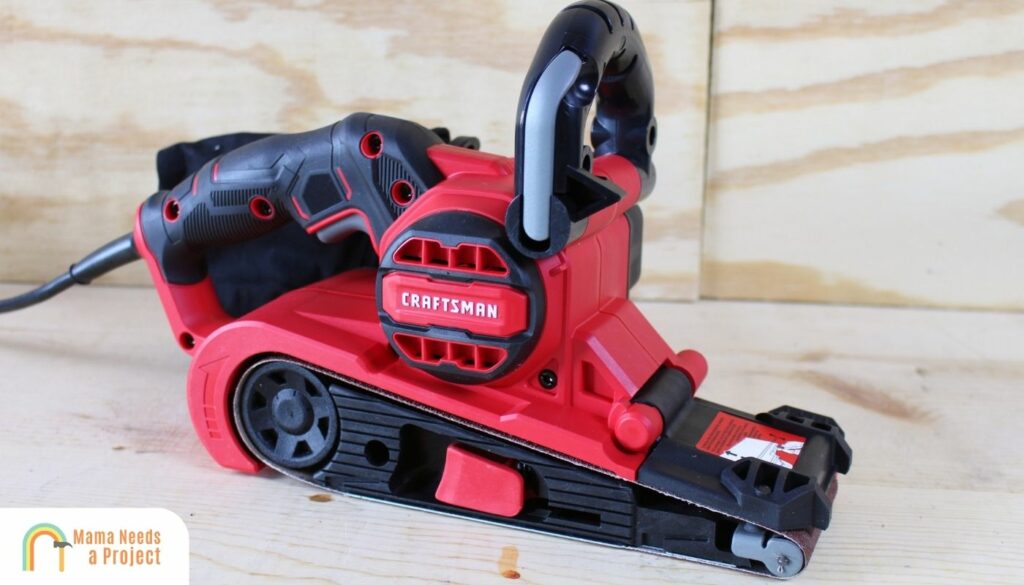
- 7.0 amp 3in. X 21in. Belt sander with an angled belt Design to sand closer to adjoining surfaces
- Max 800 FPM For fast material removal
- Tool-free belt release for quick and easy belt changes
The Craftsman CMEW213 Belt Sander is designed for homeowners who want an affordable, reliable sander. It takes a 3” x 21” belt, which is powered by a 7-amp motor. While it’s not absurdly aggressive, it’s more than tough enough to get through a large deck job.
Then again, there are a couple of features that are worth pointing out. To begin with, there’s a large plastic handle over the top of the housing. This is much easier to hold onto than a smaller forward grip. Meanwhile, the large nylon dust bag holds an impressive amount of sawdust.
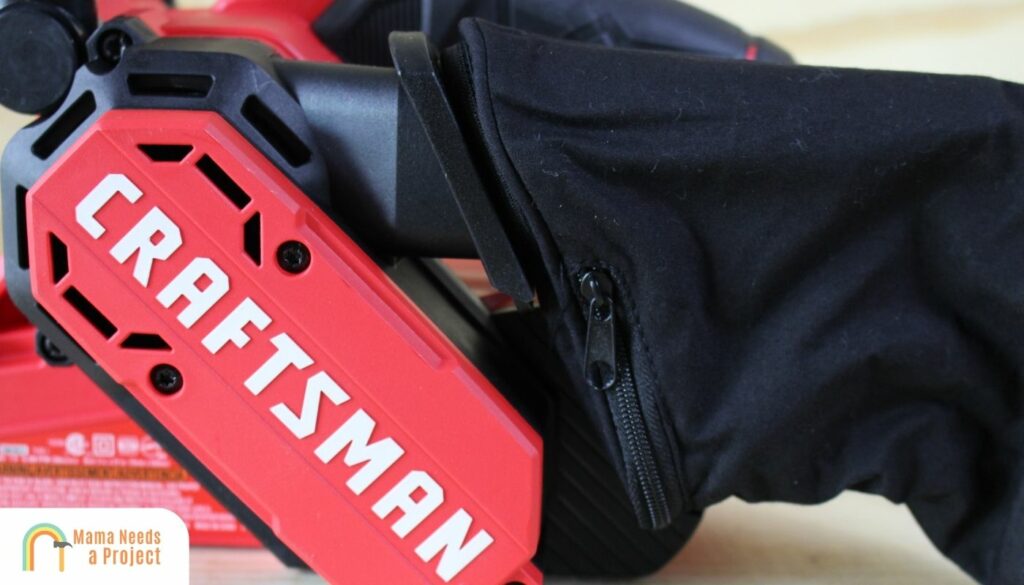
And if anything goes wrong, you’re protected by Craftsman’s 3-year manufacturer’s warranty.
What I Liked:
- Large wood dust capacity
- More affordable than other options
- 7 amp motor is on the more powerful side
- Longer, 3-year warranty is nice
What I Didn’t Like:
- Has a narrow belt
- Can’t easily tell how full the dust bag is
- Not quite as powerful or efficient as other models
My Thoughts
The Craftsman CMEW213 Belt Sander is the best belt sander if you’re on a budget. It’s large enough to complete your wooden deck refinishing project and other woodworking projects and it also has a decent dust collection system. It also comes with a longer 3-year warranty which is certainly a plus.
More Stores
6. BLACK+DECKER Orbital Sander – Best Budget Orbital Sander
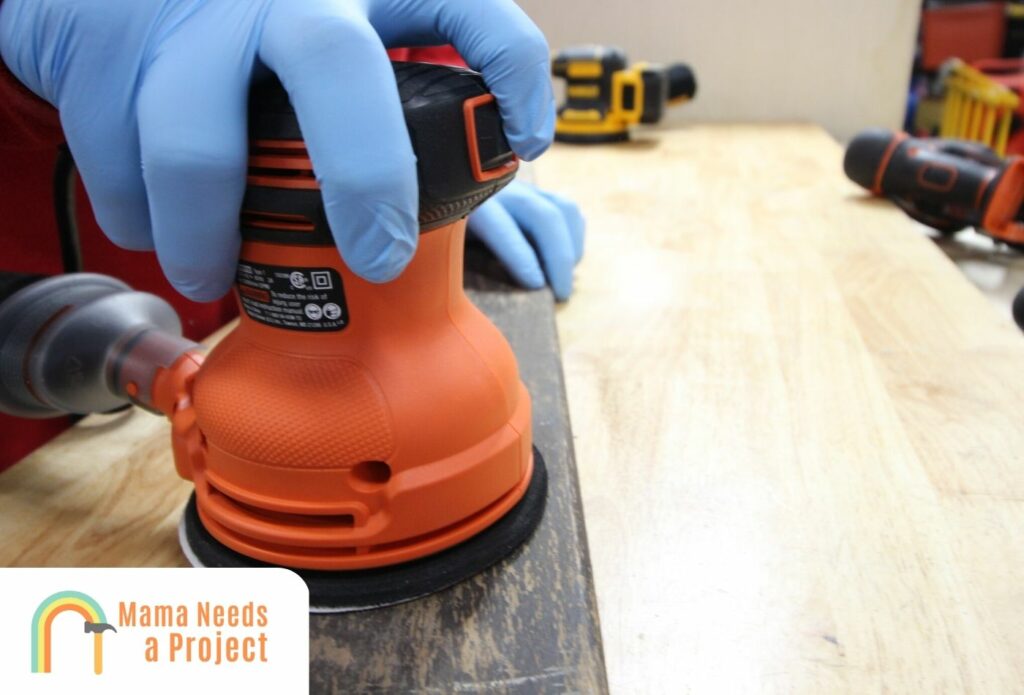
- HIGH PERFORMANCE ORBIT SANDER – 2.0 Amp corded electric random orbit sander for a swirl-free finish
- HIGH EFFICIENCY – Delivers 12000 OPM (orbits per minute) to quickly sand material
- LIGHTWEIGHT & COMPACT – Fits in tight spaces for more versatile sanding
If you’re looking for a small, compact sander that get’s the job done for smaller decks, this BLACK+DECKER Orbital sander is a surprisingly good choice.
With a 2 amp motor that produces 12,000 OPM of speed, I found this sander does a great job of smoothing out the surface of your deck without a problem.
Additionally, because of it’s smaller size, I found that you don’t get any shoulder fatigue like you do with larger sanders.
What I Liked:
- More powerful than you’d think
- Great value for the price
- Comfortable and lightweight so you don’t get any shoulder pain
What I Didn’t Like:
- Size makes it a poor choice for large decks
- Can overheat after some time
My Thoughts
If you’re looking for an affordable deck sander that will get the job done, this BLACK+DECKER Orbital sander does a surprisingly good job. Despite its smaller 2 amp motor, this sander makes easy work of even the toughest decking. My only complaints are the smaller size and I did find that it tends to overheat after consistent use but if you’re working on a smaller deck – it should have no problem.
7. Makita BO4900V Sheet Sander – Best for Small Decks
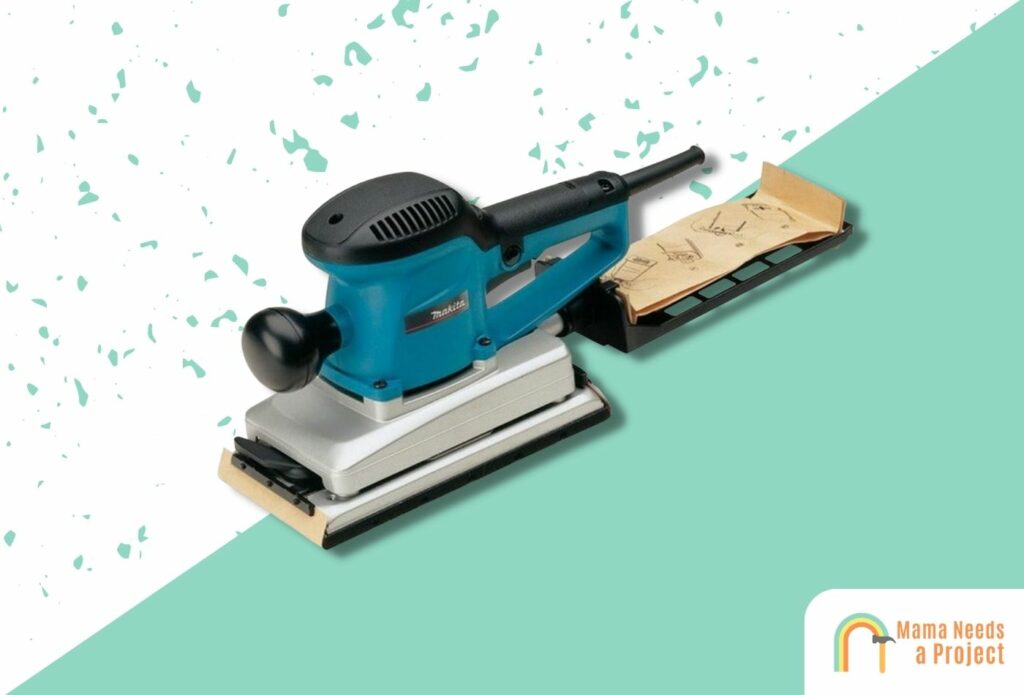
- Uses commonly available 4-1/2″ x 9-1/8″ hook-and-loop or 4-1/2″ x 11″ half sheet abrasive paper
- Efficient through-the-pad dust collection system for a cleaner work environment
- Minimized vibration and contoured grips for added comfort
The Makita BO4900V Sheet Sander is a large sheet sander that can cover a correspondingly large area. It requires 4-1/2” x 11” half sheet paper, which is the largest standard size for electric sanders. Alternatively, you can use 4-1/2” x 9-1/8” hook and loop pads. They’re a bit smaller, but they’re easier to switch out.
That said, the mechanical retention clips are also easy to operate. They do a superb job of retaining paper, which is important when you’re pressing down and moving the sander around a lot. On the downside, the paper seems to wear down faster than with other sanders.
The housing is well-engineered, with an extra grip on the front for two-handed operation. A 4,000-10,000 RPM speed dial allows you to switch tasks with ease. And a large dust bag with a powerful vacuum keep the mess to a minimum.
This isn’t the best option for deck sanding on large decks, but it’s great for small decks and other projects.
What I Liked:
- Uses large 11-inch half sheets which make the sanding process faster
- The ergonomic design was comfortable and my hands never felt tired
- Includes an excellent dust collection system that collected almost all of the dust particles created
What I Didn’t Like:
- It went through sandpaper very quickly, so I had to order many sheets
- A little more expensive
My Thoughts
Ultimately, this Makita BO4900V Sheet Sander isn’t my favorite choice for deck refinishing, but it does a decent job. While it did have the power and and a decent sized surface, it went through sheets fast and wasn’t able to sand down the wood nearly as effectively as others. That said, it’s one of the more versatile sanders on my list so you can use it for all sorts of tasks from sanding furniture to other projects.
More Stores
Which Type of Sander is Best for Decking?
Here’s my take. If you’re experienced with belt sanders, use a belt sander. If you’re not experienced with belt sanders, consider practicing with one on a piece of scrap wood. It won’t take long to get the feel for it, and you’ll finish your deck job that much faster. If a belt sander still makes you uncomfortable, go with an orbital or sheet sander.
You can also check out my guide to belt sanders vs orbital sanders for more info!
What to Consider When Buying a Deck Sander
Speed Controls
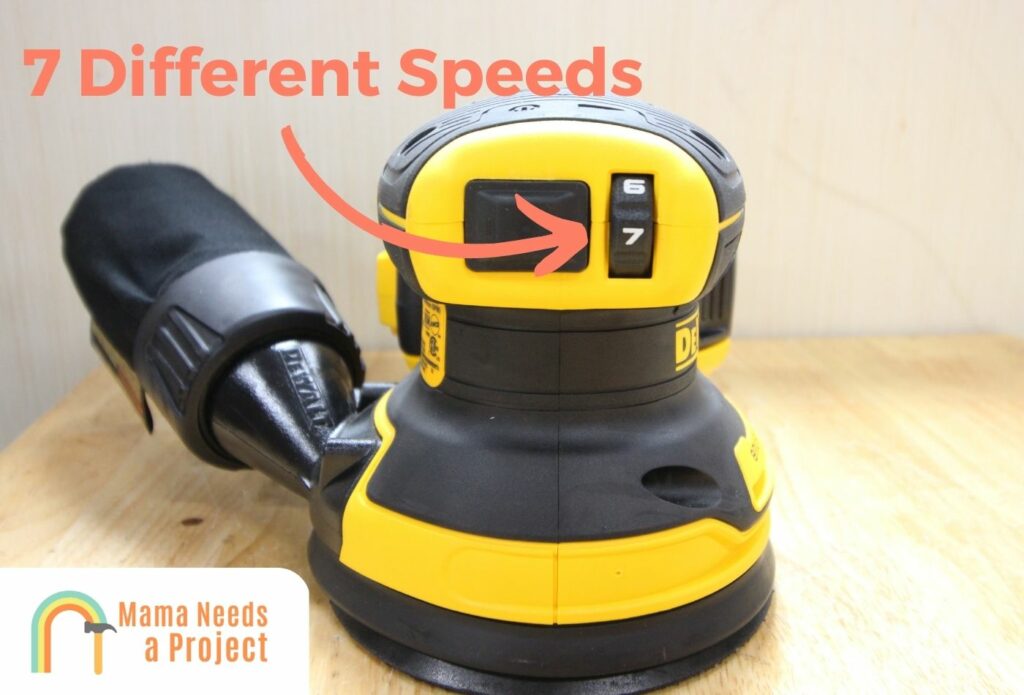
At first, it might seem like the fastest sanders would automatically be the best. The faster your motor runs, the faster you can get your job done! The reality is a little bit more nuanced.
You’ll want to sand at different speeds for different purposes. The most obvious example is your railing, where you’ll typically want to sand at a slower speed. The same goes when you’re trying to smooth out a minor imperfection.
For this reason, it’s best to look for a variable-speed sander. That way, you can adjust your speed on the fly for any application.
Dust Collection
Deck sanding creates a ton of dust, especially when using an electric sander.
Therefore, having a sander with a proper dust collection system is required. This isn’t optional, in my opinion.
The most important feature to look for is the size of the collection bag or hopper. The bigger the better, since you’ll have to replace it less often.
Noise
Compared to other concerns, noise is a minor consideration. But it’s still something you should think about when you’re choosing your sander.
If you have a large deck, you might be sanding from morning through the evening. Working all day with an obnoxiously loud sander can damage your hearing and do you really want to hear your neighbors complain? I didn’t think so. Try to find a quiet sander that’s powerful.
Types of Deck Sanders
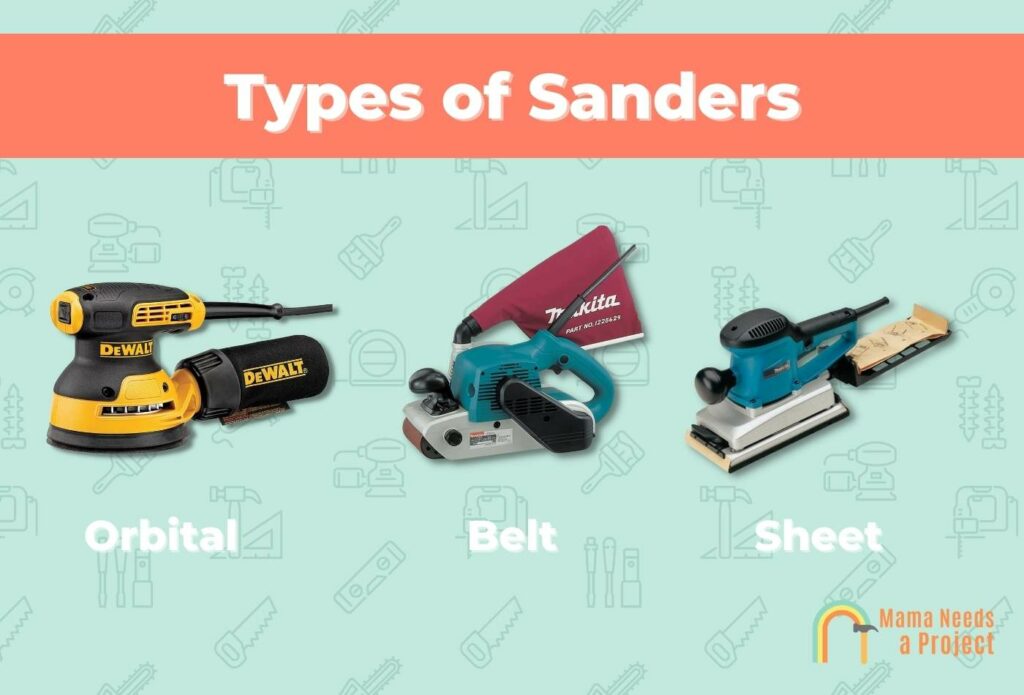
Belt Sanders
Belt sanders are the most aggressive type of sander. The constant movement of the belt makes quick work of raised grain, paint, and stain. They’re the perfect tool for stripping deck wood down so you can refinish it.
That said, belt sanders also have some downsides. For one thing, you have to remain constantly in motion. Stay in one place, even briefly, and you’ll sand a divot into your wood deck. Another thing, you can only sand parallel to the wood grain. Cross-grain sanding will ruin your finish, leaving it with a scarred appearance that nobody wants.
You can order belt sanders in multiple sizes, based on the width and length of the belt. The most popular sizes are 3” x 18”, 3” x 21”, 3” x 24”, 4” x 21”, and 4” x 24”.
Random Orbital and Sheet Sanders
Random orbital sanders are the Swiss Army Knife of power sanders. They can do just about anything, from heavy-duty work to finishing.
Don’t get me wrong; a belt sander is far more aggressive, and a finishing sander can get you a smoother finish. But a random orbital sander will be “good enough”. The same is true of sheet sanders.
There are two main differences between random orbital sanders and sheet sanders.
First off, sheet sanders use half or quarter sheets of sandpaper. The papers attach with mechanical clips, which are very secure, but which can also be a pain to lock in. Random orbital sanders, on the other hand, use a 5- or 6-inch circular sandpaper with a hook and loop backing. The backing makes them a breeze to swap out, but the hook and loop connection can weaken as the pad on the sander gets dirty. You’ll need to blow it out occasionally with compressed air to keep it clean.
The other difference is the motion of the sandpaper itself.
On a random orbital sander, the head moves in a random motion. As a result, it can be used cross-grain as well as with the grain, since it won’t leave any scratches. A sheet sander, on the other hand, moves in a predictable orbit. It will leave scratches if you try to sand against the grain.
That said, both random orbital and sheet sanders are suitable for similar types of work. They’re good for large, flat areas like the surface of your entire deck. You can use one for stripping if you’re patient and you don’t want to risk using a belt sander. Alternatively, you can start sanding with a belt sander, then follow up with an orbital sander for the final pass. Either way, an orbital or sheet sander will be essential for refinishing your deck railings.
Finishing & Sheet Sanders
Finishing sanders are ideal when you want to give your wood an ultra-smooth, polished finish.
When a random orbital sander won’t get you the smoothness you desire, these are what you use. They function similarly to sheet sanders, with standard ¼, 1/3, or ½-sheet designs.
How to Sand a Deck
The first step to sanding your deck is to power wash it. If you have an existing finish, try to remove as much as you can. Use the yellow (medium) tip for your pressure washer if need be, but be careful not to get too aggressive and gauge your wood. Never use the red tip under any circumstances. It will damage your deck.
Even if your deck is brand new, don’t skip the pressure washing step. It will remove any dirt or debris from the surface. The water will also soak into the surface, raising the grain. This makes it far easier to sand smooth.
When you’re done pressure washing, give your deck a full 24 hours to dry out. This means a full day with no rain. It can help to check the weather forecast in advance and plan accordingly. That wait, your project doesn’t get further delayed.
If necessary, you can fill any holes or cracks in your deck with one of these wood fillers for decks. Be sure to let the filler dry before staining.
Next you can sand and stain your deck for a new finish! Be sure to check out these deck stains for pressure treated wood.
Choosing the Right Sandpaper
There are a number of sandpapers to choose from, and I could easily go off into the weeds talking about different types and materials. For deck sanding purposes, any sandpaper will work as long as it’s designed for wood.
Instead of worrying about the brand of sandpaper, look at the grit. A lower grit number indicates a coarser sandpaper, while a higher grit number indicates a finer paper.
If you’re stripping an old finish, start with an ultra-coarse 360-grit paper to remove the finish, then follow up with an 80-grit paper to smooth things out. If you’re starting with fresh wood, you can skip straight to the 80-grit paper.
Either way, you should make a final pass with 150-grit sandpaper. This will eliminate any remaining rough patches and leave you with a smooth surface. This fine, final pass also opens up the wood pores, which allows your paint or stain to adhere better.
For more tips on technique, check out this video!
Deck Sanding Safety
As with any home improvement project, deck sanding comes with its share of safety risks. It’s not as if you’re working on your roof or wiring in a new circuit breaker. But there are still a couple of dangers to consider.
To begin with, your sander will kick up a lot of dust. Even if it has a good quality collection system, you’ll find that the air is full of sawdust. Deck boards are typically pressure treated, so this dust is full of toxic chemicals. The same goes for any finish you sand away. Before you start sanding, gear up with a dust mask and a pair of safety glasses. If you use a respirator and full goggles, so much the better.
Knee pads are a must. You’ll be down on your knees all day, and decks aren’t exactly known for their comfort. A good set of heavy work gloves is also a good idea. They’ll help to prevent bruises and chafing.
What sandpaper should I use for my deck?
It depends on the deck’s condition. For new wood, start with an 80-grit sandpaper, then finish up with 150-grit paper. For wood with an existing finish, follow the same process, but start with a 36-grit paper.
Can I remove deck paint with a sander?
Absolutely! A coarse-grit sandpaper can remove just about any finish, including polyurethane or varnish. Be careful about very old decks, though, since the paint might contain lead. If you’re not sure, lead test strips are cheap at most home improvement stores. In the event that your deck has lead paint, you’ll need a particulate respirator to safely sand it.
Final Thoughts
The best sander for deck refinishing is the Makita Belt Sander. It’s powerful, durable, and has a great dust collection system to making sanding your deck surface easy.
If you’re looking for a budget friendly option, go with this Craftsman Belt Sander. It’s a tremendous value given the price and it’ll make the sanding process easy.

